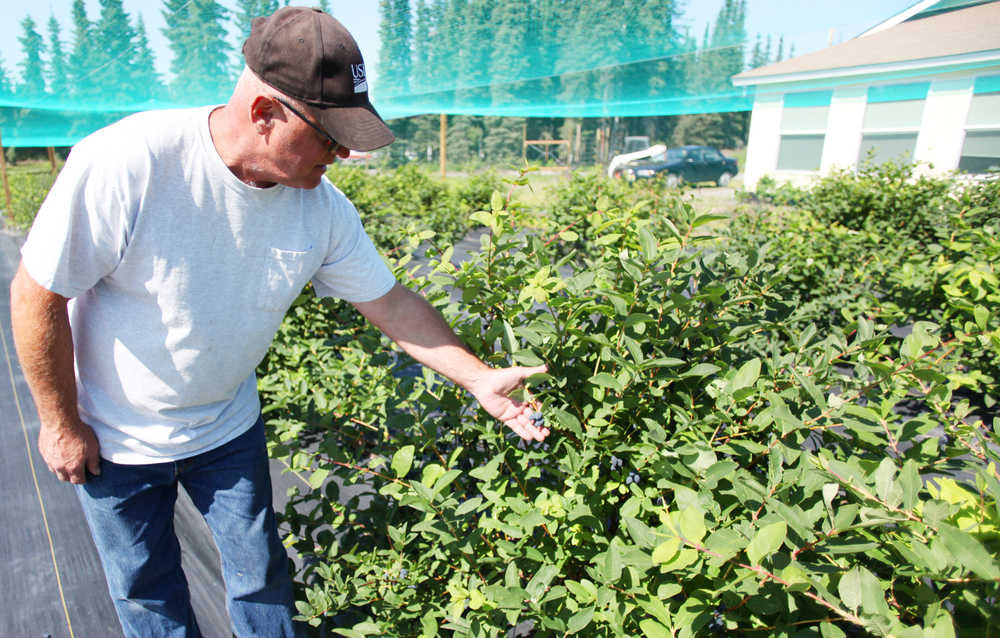Haskaps are nearly ripe and ready for picking. The tiny fruit, rare anywhere outside of Hokkaido, Japan, is only found in one spot on the Kenai Peninsula.
Brian and Laurie Olson, owners of Alaska Berries, are not holding the location of their rare stash hostage.
“In ten years I think everyone will have heard of this berry,” Brian Olson said.
The thick, oblong berries that resemble deformed blueberries are “about one week out,” Olson said as he walked beside a row of four-foot-tall plants.
The species, which has three times more antioxidants than a blueberry, is best known for its health benefits, Brian Olson said.
Right now biting into an unripe haskap yields a sour taste and bright, green center. Within days, the thin skin— a dark blue pastel— will protect juicy, crimson-red flesh that tastes “kind of like eating a grape, a blueberry and maybe a raspberry all at once,” Brian Olson said.
Laurie Olson asserts the berries really are more of a “blueberry, strawberry and raspberry,” combination.
“Taste is so subjective,” Brian Olson said. Luckily, he and his wife love the sweet fruit enough to have tried thousands and thousands throughout the past decade, in a search to find the hardiest varieties to grow in Alaska’s severe climate.
Brian Olson has planted thousands of plants, with only a select few making the cut. Every tested variety has to meet a certain set of criteria, and the ones that can’t hack it are weeded out, Brian Olson said.
The couple has found nine “proven winners,” so far.
The plants reach maturity after 3 years, when they start producing 8-10 pounds of berries annually, Brian Olson said. They can grow up to 6 feet tall and live to be 60 years old, he said.
The first standard — “they have to survive,” Brian Olson said with a laugh. Among many others, they have to “pick easy,” sprawl outwards and grow upright, he said.
And of course, they must have a good flavor, Laurie Olson said.
“That’s what we have to do to cull out the undesirables, and pull them up by their roots,” Brian Olson said.
When they started out, the Olson’s wanted to find a niche product that hadn’t been produced commercially on a large scale for their venture.
When introducing a species into a new environment, “everything is unknown,” Brian Olson said.
On many Alaska farms, production starts from the ground up. It takes years to clear land, often boreal forest, and build up the soil quality, Brian Olson said.
As any experienced farmer knows, a good harvest starts with good soil, Brian Olson said. Samples were sent off for testing to ensure the dirt was rich with necessary nutrients, but prepping the 2.5 acres for the non-native plants was based on good guesses, he said.
Laurie and Brian Olson have decades of combined experience in agriculture. Fifteen years ago they switched from vegetable production to fruit and haven’t gone back.
The couple’s success with haskaps was the first time the berry was turned into a commercial product in the U.S., when they made jam about five years ago. Now the fruit is sent directly to the on-site winery for fermentation. Months later a sweet-and-sour fruit wine, only slightly darker than the inside of the ripe berry, results.
Brian Olson said the local market “has sustained the farm’s 100 percent Alaska Grown products since the beginning.” People’s interests are piqued in products that have travelled no more than 300 feet in their entire lifetime, he said.
“The quality of the product is never better than the quality of the fruit,” Brian Olson said.
A producer can control every aspect of the condition of their commodity by growing, processing and creating onsite from start to finish, Brian Olson said. The 5-acre farms common on the Kenai Peninsula are sustainable and can yield enough to make a living off of, he said.
Reach Kelly Sullivan at kelly.sullivan@peninsulaclarion.com.

